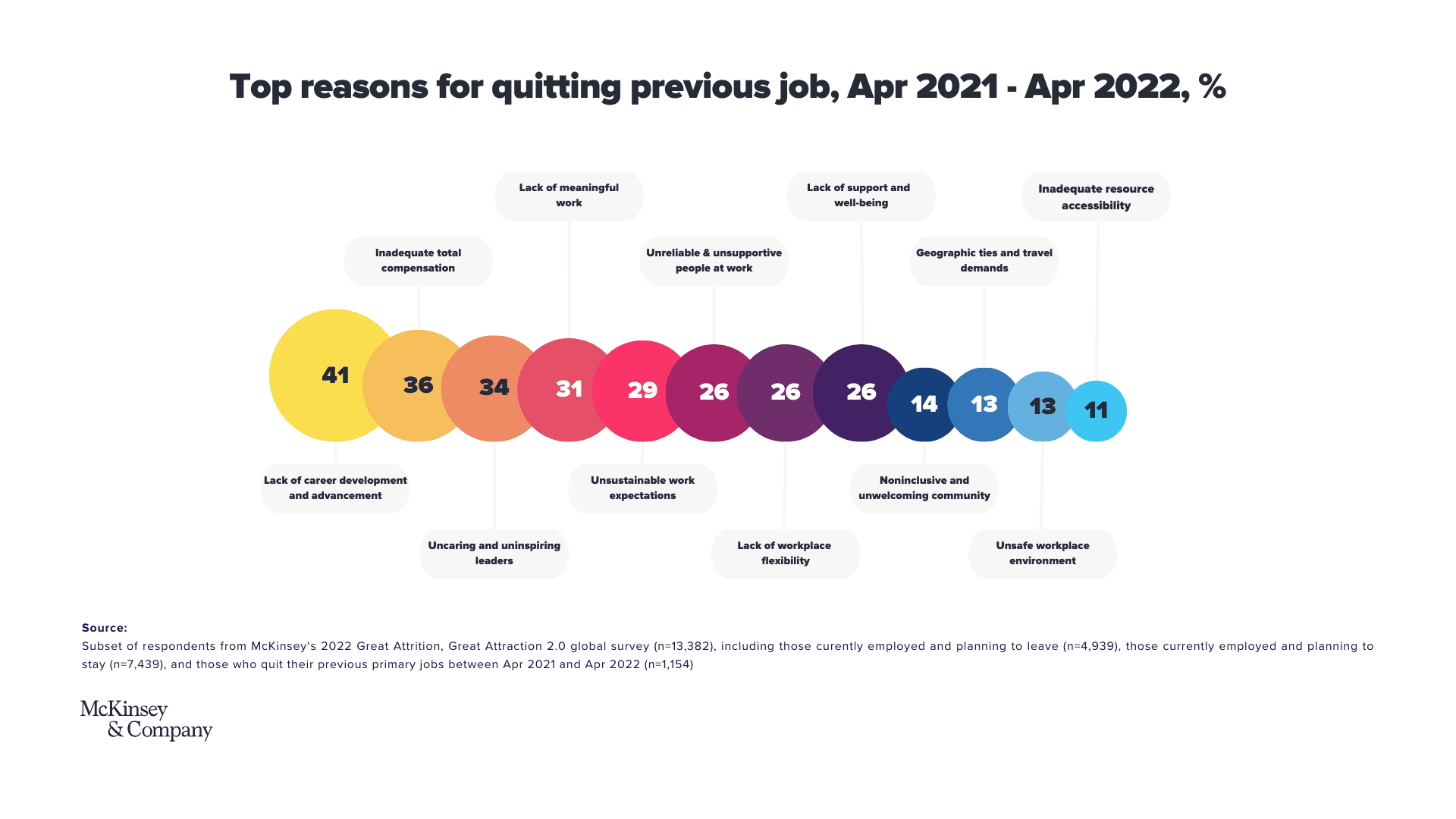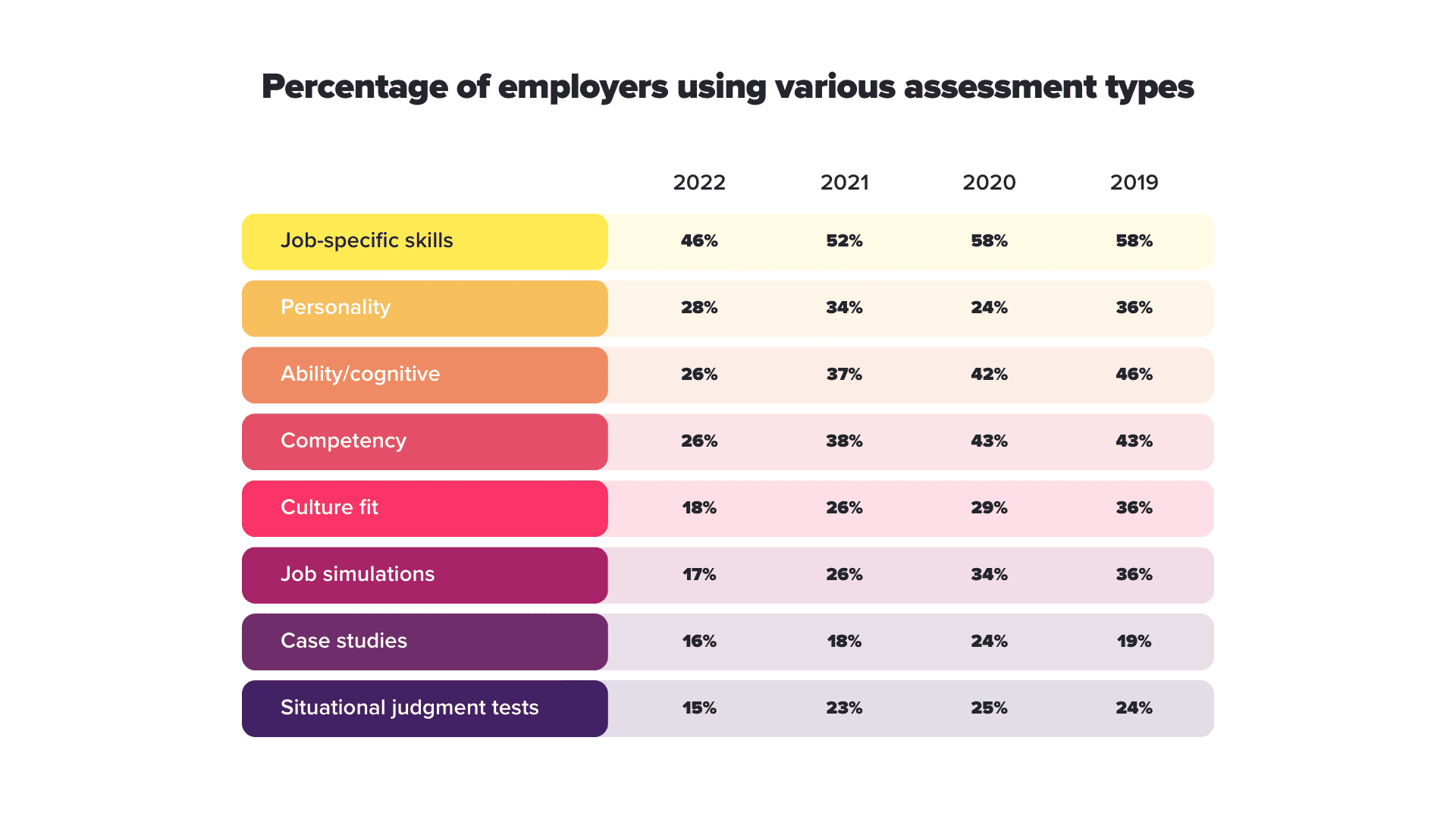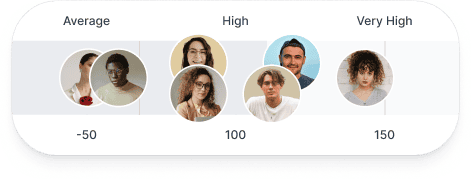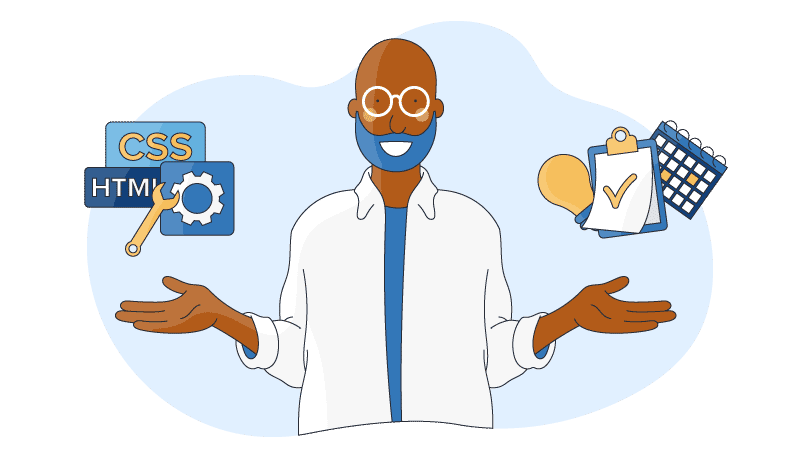Your ultimate guide to pre-employment assessments
Hiring challenges are at a 15-year high. COVID-19 has reshaped people's views on work and what they want from it. In the midst of this ‘Great Mismatch’, 69% of companies worldwide face talent shortages. Some 19 million US workers have quit their jobs since 2021. 73% of employees want flexible, remote work options and 67% feel leaders neglect their well-being, which means employee satisfaction, motivation, and company culture have suffered.
Smart hiring is the need of the hour.1

Though pre-employment testing is on the rise with many companies conducting some sort of testing.11 It's important to note that we still need to assess candidates in a way that allows us to see the full picture. Each job and company has unique requirements for hard, soft, and social skills.
This is where pre-employment assessment tools come in. These help you screen candidates through a series of steps and procedures, rather than relying on a single test to evaluate their skills.
Fingerprint for Success (F4S) workstyle assessments further support the process. These reveal candidate motivational biases or ‘strengths’ as well as ‘blind spots’. Once identified, you can work with employees to develop these traits using F4S coaching programs.
What is a pre-employment assessment?
A pre-employment assessment is a comprehensive evaluation that uses various tests and screenings such as skills tests, personality tests, and cognitive aptitude tests to provide a holistic understanding of a candidate's ability and skills. 76% of companies (with more than 100 employees) use a form of pre-employment assessment to select the most suitable candidates for a job.2
Hiring managers who use pre-employment tests are 36% happier with their new hires.1,10 Plus, they’re worth the trouble since a single bad hire costs a company US$15,000 on average.3 Not to mention the loss of time and other resources.
Some popular tests companies use to assess candidates are:

We'll discuss some of these in more detail later, but first, let's look at the pros and cons of pre-employment assessments.
What are the advantages and disadvantages of pre-employment assessments?
What are the advantages of pre-employment testing for companies?
Using pre-employment assessments, you can:5, 10, 11, 14
Improve quality of hire and hiring accuracy
With data-driven hiring, 92% of companies using pre-employment assessment reported a better quality hire.
Save money and resources
Save resources by minimizing bad hires, and avoid the time-consuming process of screening resumes, arranging interviews, and dealing with ghosting. Ghosting is when interviewees fail to show up. This practice is costly for employers, in terms of time and money.
Reduce time-to-hire
Pre-employment assessments streamline the hiring process so recruiters can make quicker and more-informed decisions, reducing the time-to-hire considerably. Companies using them have been able to reduce time-to-hire by 82%.
Avoid bad hires
Filter out misfit candidates with proper screening and tests. Companies using pre-employment assessments have reported an 88% reduction in total time-to-hire.
Reduce turnover rate
Hire employees who are fit for the job and resonate with your company culture to reduce turnover. Companies have seen an 89% increase in employee retention after the use of pre-employment tests.
Reduce bias from the hiring process
Resumes and interviews are subject to bias. Pre-employment assessments reduce bias by narrowing in on candidates' actual skills and abilities.
Provide a standard testing process for prospective employees
Give all candidates a fair and uniform experience. This allows you to make impartial and reliable hiring decisions.
Provide a well-rounded understanding of each candidate
Pre-employment assessments measure not only technical proficiency but also soft skills and social aptitude. This provides a holistic understanding of each candidate.
Collect precise information
Pre-employment assessments like cognitive aptitude tests, skills tests, and behavioral assessments elicit specific responses from candidates using targeted questions and scenarios. This provides you with specific insight into the candidate's abilities.
.png)
Forecast performance and future expectations
Motivation tests and assessments are designed using research and analysis of factors correlated to job success and by benchmarking the performance of successful performers. This allows you to peek into the candidate’s future performance. By pinpointing common traits of entrepreneurs and successful leaders, F4S also helps companies predict the future performance of employees.
Whether you're a hiring manager or a job seeker, you’ve probably witnessed how resumes and interviews can be misleading. 72% of people lie or exaggerate on resumes and interviews are subject to bias and require specialized interviewer skills.4 Poorly conducted and unstructured interviews cause more harm than good.
Once streamlined, pre-employment test results are easy to manage and identify unique talent. Consider Coupa, this company hired fresh graduates solely by testing them on their coding abilities. Using traditional employment methods, these talented individuals would have needed years to secure a job.6
In addition to finding dream candidates, companies also save time and resources with pre-employment assessment tools.
Revolut had a slow and labor-intensive process for assessing candidates' language proficiency skills, which involved manually reviewing written assignments and conducting in-person interviews. After partnering with TestGorilla, they reduced their time-to-hire by 40%.7
Canva uses F4S’ workstyle assessment as part of its onboarding process. This gives recruiters unparalleled insight into a candidate’s personal motivations, strengths, and blind spots. It also enables leaders to better understand who is on their team so they manage appropriately.
What are the advantages of pre-employment testing for candidates?
As a candidate, pre-employment assessments may seem intimidating. But when they’re well-structured and well-designed, they can be game changers.
86% of candidates have a better chance of getting their dream job, while 66% of employees discover new job opportunities through such assessments.5
Other note-worthy benefits include:3,5,10,11
- They’re free of bias.
- They lead to better job/company fits.
- Improved job satisfaction.
- They can be done online.
- Availability in several languages.
- Enhanced fairness.
- Candidates gain insight into their own strengths and weaknesses.
- Everyone gets a standardized and objective evaluation process.
Wondering how pre-employment assessments open up new doors? I did too, so I dug deep and found this inspirational example.
Dawn Gllfillan, a commercial photographer, faced many barriers and age bias while applying for jobs. She finally found her dream job not as a photographer but as a content writer at TestGorilla after scoring high on their job skills test. She possessed the talent from the start, but the assessment ultimately unlocked the opportunity for her, which wouldn’t have been possible with resumes and interviews.
Since then, Dawn has been a big advocate of pre-employment assessments. TestGorilla proudly features Dawn, who expresses her enthusiasm, stating,
"Skills-based hiring has been a revelation for me. I was unaware of its existence before discovering TestGorilla. I used to think there was no hope for me because everyone relies on your CV. However, I secured this job based on merit alone, and it feels incredibly rewarding. It has restored a lot of my self-confidence."9
What are the disadvantages of pre-employment testing for companies?
Pre-employment testing can be expensive, requires time for streamlining, necessitates specialists for structure and design, and may take some adjustment.
Designing well-structured pre-employment assessments can be tricky. When they’re not properly designed tests can:12
- Cause applicants to drop out and/ or increase time-to-hire if they are long and unengaging.28
- Stress managers financially, especially in smaller companies with limited resources.
- Require additional resources in terms of managing candidate expectations and providing feedback.
- Cause participants to lean towards answers they feel would land better with the employer.
- Sometimes not provide the whole picture. Imagine a candidate has all the right hard and soft skills for a job but doesn’t pass the personality test. Maybe they were nervous, not everyone tests well. So rejecting them based on the test could prevent a company from recruiting a suitable candidate.
What are the disadvantages of pre-employment testing for candidates?
We’ve all been there. Job seeking is stressful enough as it is. Adding pre-employment assessments on top of the process has mental, emotional, and physical repercussions, when they’re not designed with the candidate’s experience in mind. Ideally, these screening tools should be about finding the best candidate fit, not putting candidates under unnecessary stress. Plus, tests and assessments need to be conducted so that candidates understand what is happening and why.
Take Hoang’s example. Hoang Samuelson is an accounting and finance professional. After investing a full day navigating multiple assessments, ranging from skills tests to personality tests, she was rejected. The sting of the rejection was amplified by the lack of accompanying explanation. This led her to vow to never apply to that company again.13
She also felt these tests weren’t foolproof as people can easily lie on personality tests to make themselves look better. Plus, the whole assessment process made her anxious and stressed, which didn’t help her performance.
But this doesn't mean all pre-employment assessments are bad. You need to find the sweet spot to avoid overwhelming a candidate while creating an enjoyable learning experience. Even if a candidate doesn't secure the job, they gain insight about themselves, their preferences, and their abilities so they walk away with something.
What are the most effective pre-employment assessment tools?
Personality tests
Around 80% of Fortune 500 companies use personality tests for recruitment, employee development, and team development. These tests don't have right or wrong answers. They are tools to assess the candidate pool on various aspects, including cultural fit, aptitude, and career progression.
The aim of personality tests is to identify a candidate’s strengths and areas for improvement. Businesses use this information to build higher-performing teams. Some common personality tests are:
- Big Five Personality Traits (OCEAN Model)
- Myers-Briggs Type Indicator (MBTI)
- DISC assessment
Motivational traits assessment
These tests evaluate individual motivators and drivers using motivational traits assessments. This enables companies to understand what factors motivate people, and are crucial for personal development, team dynamics, and career decisions. Some motivational factors are achievement, recognition, autonomy, and other intrinsic and extrinsic factors.
Fingerprint for Success (F4S) is a research-based personal and professional development technology that uses a motivational assessment to help companies and individuals understand their core strengths, motivating drivers, and areas for development.
-min.gif)
Companies using F4S require 90% fewer interviews to find the right candidates and have achieved a substantial 752% return on investment within the first year. Once you understand your employees' intrinsic and extrinsic motivations, you can fine tune your recruitment, hiring, and onboarding processes accordingly.
Accelerate understanding between teams
Breadth

Motivated by macro big picture thinking, these teammates value moving quickly to connect dots between abstract ideas to 'get the gist' of things.

vs
Depth

These teammates value being concrete and specific, getting into details to understand the steps or tasks required.

See the different work styles in your team
Take the free assessment & set up your teamTake Canva’s example. Being one of the fastest-growing tech companies, they recognized early that they needed a strategy to maintain their unique culture. For this, they incorporated F4S in their onboarding process to develop high-performing teams and leaders and empower their people to reach their full potential. F4S enables Canva to assess team dynamics and compatibility, ensuring that teams are structured to embrace cognitive diversity.
.png)
Psychometric assessments
These assessments evaluate an individual's psychological attributes, including aptitude, personality traits, cognitive abilities, emotional intelligence, and behavioral style. Psychometric tests have become a standard practice in hiring as they offer valuable insights into how people respond to various situations.10
Skills tests or skills assessments
Evaluate an individual's hard and soft skills, essential for success in a specific role. Typically, skills tests present candidates with various questions in different formats to assess their performance in job-related tasks.
The majority of employers find skills-based hiring effective for talent identification (91.9%), on-job success (88.8%), and longer employee retention (81.8%).5

Cognitive aptitude tests or cognitive ability assessments
These measure a candidate's potential to apply mental processes in addressing workplace challenges. They focus on how a person thinks rather than what they know. They assess intelligence or general mental ability and provide insights into a person’s ability to handle complex mental tasks effectively. They also evaluate attention to detail, memory, problem-solving skills, critical thinking skills, abstract reasoning skills, and verbal comprehension skills.
Some examples of less common pre-employment assessments:
- Emotional intelligence tests examine a candidate's ability to control their emotions and their ability to empathetically interact with other workers. These identify skills in areas of leadership, teamwork, calmness under pressure, conflict resolution, and empathy toward others.
- Job knowledge tests evaluate an individual's understanding of specific job-related information, facts, or concepts. They’re different to skills tests as they don’t measure level of skill or talent but the level of knowledge and expertise a person possesses in their field or role. This includes knowing and understanding industry jargon, the nature of the job and the typical tasks associated with it. This knowledge usually comes with a candidate’s experience.
- Logical reasoning tests evaluate an individual's ability to think logically, solve problems, and make sound decisions. These are commonly used in recruitment and educational settings to assess a person's critical thinking and problem-solving abilities.
- Numerical reasoning tests measure a candidate’s ability to work with numbers and interpret quantitative information. Used in hiring for roles that require strong numerical and analytical skills, such as finance, data analysis, and other professions involving quantitative information.
- Programming language tests evaluate an individual's proficiency in specific programming languages like Python, Java, C++, and others. Coding tests and programming tests are commonly used in the tech industry for technical job interviews and assessments to gauge a candidate's coding and programming skills.
- Physical ability tests assess an individual's physical capabilities and fitness for specific job roles. They are commonly used in professions that demand physical skills, such as firefighting, law enforcement, construction, or the military.
- Integrity tests determine an individual's honesty, ethics, and trustworthiness. They’re often used for roles where trust and ethical conduct are critical, such as positions in finance, security, or law enforcement.
Who uses pre-employment assessment tools?
Many organizations and industries use pre-employment assessments. Some examples include healthcare, finance, manufacturing and production, sales and marketing, customer service, technology, IT, government agencies, educational institutions, and nonprofit organizations.
In fact, a whopping 76% of employers incorporate some form of pre-employment skill testing. 46% use personality or psychological assessments, while 41% assess applicants for fundamental literacy and math skills.10
Take Amazon as an example. They use a variety of pre-employment assessments such as Amazon WorkStyle Assessments to assess work-related preferences and decision-making style, Amazon Work Simulation to evaluate a candidate's ability to perform tasks, and Amazon Leadership Principles Assessment to determine if candidates possess qualities such as customer obsession, ownership, and bias for action.
Walmart uses the Walmart Assessment Test to measure candidates’ abilities to understand and handle different situations with customers and whether they would be able to work under supervisors and with co-workers.
H&M uses a combination of pre-employment tests such as numeracy tests, inductive logical thinking tests, psychometric tests, deductive logical reasoning tests, and situational judgment tests to screen candidates.
DaVita uses personality assessments to ensure they hire individuals who contribute to a positive work environment and align with the company's culture.
State Farm uses the PI Learning Indicator (PILI) to evaluate a candidate's overall learning capacity and aptitude for grasping and adapting to new concepts in a workplace setting. The test is split into non-verbal reasoning, verbal reasoning, and numerical reasoning.
Almansons streamlined their recruitment process using Xobin’s skill test. They reduced their screening time and provided comprehensive tools to assess job skills. This enabled them to identify relevant technical skills leading to a qualified candidate pool with strong logical and technical abilities.
The science behind pre-employment assessments

Pre-employment assessments are rooted in science and are meticulously developed. For example, cognitive ability tests use standardized tools to give objective insights into strengths and weaknesses across different mental skills such as memory, attention, and language.15 These tests scientifically measure how well the brain works by evaluating task performance. They are highly effective predictors of job performance.16
Personality tests, however, evaluate individual characteristics, traits, and behavioral tendencies. Consider the Myers-Briggs Type Indicator (MBTI). This test is based on Carl Jung's analytical psychology, which uses 3 dichotomies: extraverted/introverted, sensing/intuition, and thinking/feeling.
According to research, each trait has 2 distinct levels and no middle ground. Two more personalities were later added by Katharine Cook Briggs and Isabel Briggs Myers creating a total of 16 personality types. Although people's traits vary along a scale, the use of these 16 types works well for personality research.17
Personality tests are much harder to design and administer than tests for technical abilities. The best way to get reliable and valid results with personality tests is to take them more than once, take multiple types of personality tests, and have someone else complete a test about you.18
Coming to the F4S assessment, the science behind our assessment is evidence-based. After analyzing the behaviors, motivations, and attitudes of entrepreneurs and business builders for more than two decades, Michelle Duval, F4S Founder and CEO, a highly renowned transformational and development coach, was able to pinpoint common motivations shared by successful entrepreneurs and business leaders.
As Michelle worked with her clients, she noticed patterns emerging that distinguished those who succeeded from those who failed. Duval explains:
"What often is a blind spot for most hiring teams or managers is that they focus on hard/ technical skills. But what they don't realize is that if their (candidate’s) attitudes don’t align with the performance, task, team culture, and actual goals of the team, the team dynamics will cause them to fail. In reality, attitudes and motivations impact career success more than talents, aptitude, and experience." - Michelle Duval, F4S Founder and CEO
This is why F4S assessments can help you predict future success.20 Use F4S as an employee onboarding platform and it will create a truly bespoke experience for new hires. Start with our highly accurate work style assessment, which measures 48 different traits. Our robust set of scientifically supported features will inform every aspect of the employee lifecycle; from talent acquisition to ongoing performance management.
You can also use our XFactor Model to identify low, medium, and high-performing candidates during the hiring process, or for evaluating current employees. This will help you develop high-performing teams and future leaders.
Tips for employers: choosing the right pre-employment assessment tool 19,26
- Test selection
- Choose tests that measure specific job-related abilities and skills.
- Conduct a job requirements analysis to identify the skills, work activities, and abilities associated with the job profile.
- Integration timing
- Administer tests as early as possible in the hiring process to gather objective data efficiently.
- Use remote testing methods, but consider confirming results through in-person retesting, especially for aptitude and skills tests.
- Testing duration
- Keep the length of tests to 40 minutes or less to maintain a high completion rate (around 80%).
- Consider dividing tests between different stages of the hiring funnel.
- Benchmark
- Administer tests to existing employees in similar positions to establish reliable benchmarks for applicant scores.
- Tailor target scores to the company’s current standards.
- Set cutoff scores
- Establish minimum cutoff scores (based on testing current employees) to filter out unqualified candidates.
- Avoid using maximum cutoff scores unless there is a special circumstance. High scores don’t always mean a high risk of turnover.
Tips for job seekers: how to pass a pre-employment assessment

- Make sure you understand the specific requirements and expectations of the job you're applying for to align your responses with the role.
- Familiarize yourself with the industry and domain in which the company operates to demonstrate relevant knowledge. If possible, communicate with the hiring team to gain insights and a better understanding of what they're looking for.
- Your responses should reflect your self-awareness and fit within the context of the job.
- Identify your strengths and remind yourself of the skills and abilities that make you a strong candidate.
- Practice with mock assessments to become familiar with the format and types of questions commonly found in pre-employment tests (resources are mentioned below.)
- Arrive early for in-person assessments. For online assessments, ensure your computer and internet meet the requirements.
- Pay close attention to each question and respond in a way that relates to the workplace or job context.
- Consistency is key. Strike a balance in your responses, and maintain a consistent approach throughout the assessment.
- Maintain your composure and confidence while taking the assessment to perform at your best.
- Remember, rejections are part of the journey. If you face setbacks, view them as opportunities for growth and learning.
Resources
Speed up your job search and hiring efforts using our list of handpicked resources.
Pre-employment assessment tools for employers
- F4S Assessment: Find candidates that resonate with your team and company culture. Trusted by Canva. Book time with our team to discuss F4S assessment tools for your business.
- TestGorilla: Has 300+ scientifically created tests. TestGorilla partners with more than 9,000 companies and has helped fill 130K jobs.21
- Toggl Hire: 180+ skills tests for different job roles and saves companies 22 hours per job opening.22
- Adaface: 750+ custom assessments for on-the-job skills. Trusted by companies such as Amazon, Adidas, and Vodafone.
- Codility: Tests for 90+ coding languages. Trusted by companies such as Swift, Unity, LiveRamp, and Asseco.
Pre-employment assessment tools for job-seekers
- F4S Talent Pool: Exciting new tools for job seekers (coming soon!) to find a role you love with people you love based on your motivations and values.
- JobTestPrep: Offers a wide range of practice tests for job-seekers.
- Practice Aptitude Tests: Gives access to 16 different types of practice psychometric tests.
- TestHQ: Challenging pre-employment tests cover personality tests, cognitive aptitude tests, and leadership abilities. (Paid)
- Practive4me: Offers a range of practice tests along with tips, guides, and practice videos.
Want one-on-one support from an expert coach to help you with your assessments and career goals? Use our coach directory to find a coach that is perfect for you and book a free introductory coaching session.
Job sites
According to a poll by Monster.com in Jan 2023, 96% of workers were looking for new positions mainly in search of better pay. However, by June, only 32% had transitioned to new roles. So if you’re looking for better opportunities, we’ve collected this list of the 5 best hiring websites in 2023.
- Indeed: Indeed has a total organic traffic of 185.8M from around the world. This makes it the leading website for hiring by employers and job-seekers.
- LinkedIn: LinkedIn is the world’s largest professional network. It is also being used for hiring by employers and employees. With more than 58M listed companies and 52M job seekers (weekly), LinkedIn has become a go-to tool for recruiters with 77% using it regularly. 23
- Glassdoor: Search millions of jobs with Glassdoor job search. It is one of the leading recruitment websites with more than 8.1M organic traffic per month.
- Monster: Monster is a great source for jobs and career opportunities. It receives more than 2.4M monthly organic visitors from around the world.
- ZipRecruiter: With a rating of 4.8 on G2, ZipRecruiter is an excellent option for sourcing job opportunities and finding talented candidates. It has more than 11.6M monthly visitors from around the world.
- CareerBuilder: CareerBuilder is one of the most trusted sources for job opportunities and advice. It attracts 1M organic visitors globally.
Create the right pre-employment assessment for your business
Recruitment and selection are challenging. 73% of employers face challenges in the hiring process, with 66% expressing difficulties in retaining staff.24
Taking the time to create a good pre-employment assessment process is key to successful hiring. Companies using these tools see better talent acquisition (92%), an 88% decrease in time-to-hire, and an 89% increase in employee retention.5 You can achieve similar results with the right pre-employment assessment tool.

FAQs
1. How do I pass personality assessments?
You don’t need to study for personality tests.
- Research the company to understand the company's culture and values.
- Don't overthink, just be yourself. Answer questions truthfully to reflect your genuine personality.
- Respond naturally rather than trying to provide ideal answers.
2. How do I pass cognitive ability and critical reasoning tests?
Here are a few tips and tricks to help you ace cognitive ability and critical reasoning tests.26
- Familiarize yourself with the format and types of questions commonly found in these tests. Learn to manage your time and pace yourself to complete all questions within the allotted time.
- These tests come with a set of instructions at the beginning. Read instructions carefully and pay attention to the specific rules and requirements
- For practice, there are many tools on the internet you can practice on. Many companies have practice tests to help give an idea of the actual assessment.
- Only use the information provided.
- Be alert to both facts and errors in the information and arguments. Identifying errors will help you answer correctly.
3. How do I pass numerical reasoning tests?
Here are a few tips and tricks to help you ace numerical reasoning tests.27
- Brush up on your math skills. Review basic mathematical concepts.
- Take your time to understand the questions.
- Keep your own calculator with you.
- Use scratch paper if allowed. Jot down calculations to avoid mental errors.
- Work on interpreting and drawing conclusions from graphs and tables to brush up on your data analytics skills.
- Manage and allocate time effectively.
- Check unit bases and percentage increases and decreases.
- Re-read the questions and check your answers.
Make smart hires with F4S pre-employment assessment
Find the best talent and create a positive learning experience that keeps your candidates motivated. Our hiring tools use a data-driven approach to remove bias and predict culture fit during the hiring process. This makes it easy to build trust with candidates and find the perfect fit. The F4S assessment also enables you to predict future success by using a scientifically grounded approach based on 20 years of research. Remember, companies that care about their candidates and employees build strong relationships and boost performance.
Recommended program for you:
Coach Marlee (your amazing AI-powered personal coach) will analyse your unique traits and goals to personalize the program so you see results as quickly as possible.
Testimonials

“Marlee helped me to work on my self-belief”

“Wow this program has totally changed my relationship to goals! Thanks so much Marlee, I miss you already”

“What profound and exciting coaching. Brilliant!”

“The Team Building coaching program has helped me gain a deeper understanding of my team and how to best lead, communicate and work with them. As a result, collaboration has become so much easier and we can better utilize our creative differences in our decision making - improving our happiness and performance!“

“This wellbeing program blew my expectations. At first I thought the program was just going to help me with weight loss, but as I went through, I got so much more. This program has helped me shift my entire thinking and attitudes about myself, helping me to prioritize my health and wellbeing. I feel amazing!”

“I’ve always found it daunting to be a leader, I have never sought out to be the one in charge. The positions have always found me. I now have new confidence. I especially like the concept of leadership through context. Very empowering”.

“Quite amazing how many things get done when they are initiated!”

“Wow this program has totally changed my relationship to goals! Thanks so much Marlee, I miss you already”
Related Articles
What’s your communication style?
Learn how to connect with colleagues and boost workplace motivation.

Name Surname
Position, Company name

Name Surname
Position, Company name

Name Surname
Position, Company name

Name Surname
Position, Company name

Name Surname
Position, Company name

Name Surname
Position, Company name
Your submission has been received!

Hack your wellbeing, productivity and goals
Programs are created by expert coaches & delivered by our incredible A.I. Coach Marlee. Sessions only take 5-15 minutes and are 100% personalized to fit your unique traits and goals.
